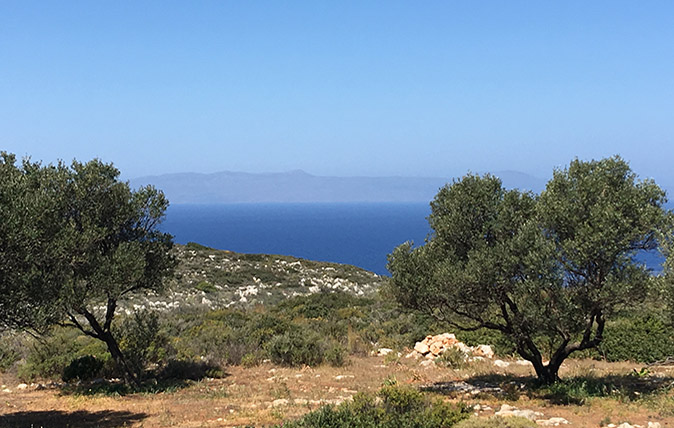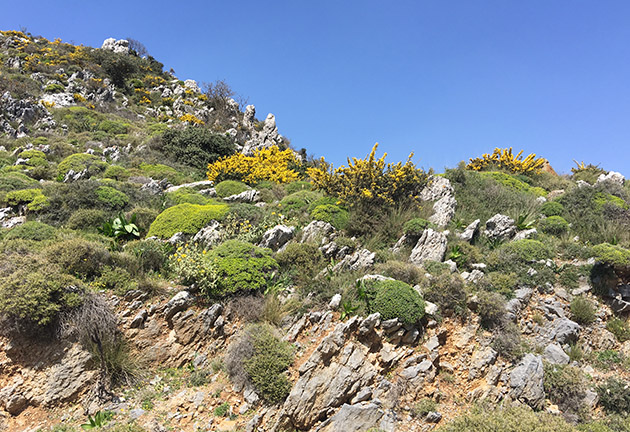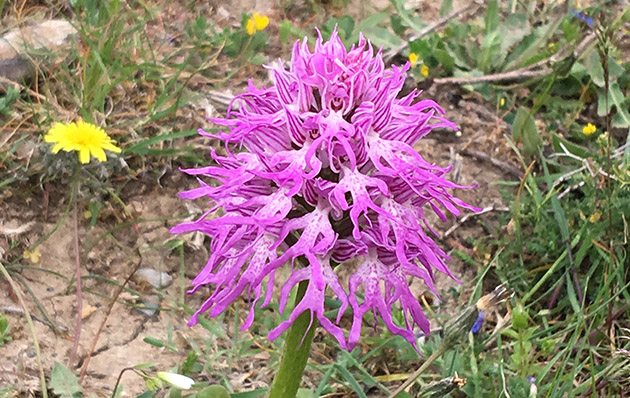Springtime in Crete – a botanist’s heaven
A well-timed tour to Crete means Gardens Editor Kathryn can experience the enormously diverse flora of this Mediterranean island guided by an expert


Kathryn signed up for a plants and gardens tour of Crete this spring which took her knee-deep through grasses, wild flowers, orchids and through beautiful groves of olive trees
I have just unpacked my suitcase – and opened a jar that I had mummified in layers of sellotape and polythene, to prevent its contents seeping out and causing havoc in my luggage. On dispensing with its wrappings, I open the lid – and am transported back to the herby hills of Crete and its country tavernas, where I’ve been spending a week in like-minded company, exploring the island’s remarkable wild flowers and dining superbly on fresh, local produce in numerous country hostelries.
You might think this jar contains honey; Crete certainly makes huge amounts of it. You see clusters of beehives on many a hill, their residents foraging the myriad flowers and herbs which give Cretan honey its rich layers of aromatic sweetness.
But in the jar is something at least as sweet but entirely different: ‘haroupomelo’, a thick, dark-brown syrup with crystalline fragments of sugars suspended in its tarry slickness. Its fragrance is difficult to pin down: essence of toffee, nutty notes, caramel and a hint of agreeable cough mixture.
I know nothing else quite like it but the Cretans use it to baste meats for roasting and to lend its sweetness to pastries and puddings, among other things. A smidgin – no more than an eighth-of-a-teaspoonful – enlivens a cappuccino, too, I’ve just discovered.
Haroupomelo is a molasses made from crushed and boiled-down carob, an ancient recipe which goes back into the mists of time, utilising the large, bean-like seeds of Ceratonia siliqua, the carob tree native to the eastern Mediterranean. Mature trees can be quite tall, with a crown that spreads widely, casting deep and welcome shade under its dense canopy of darkest evergreen, leathery foliage; but on our forays in the hills we see much more of it as scrubby bushes in the stony but plant-rich landscape.

Our mid-April days are spent in search of the richness and diversity of Crete’s flora, very fortunately guided by the leading expert in this field, John Fielding, author of the standard reference work, Flowers of Crete (published by RBG, Kew), which is illustrated throughout by thousands of his own photographs.
Sign up for the Country Life Newsletter
Exquisite houses, the beauty of Nature, and how to get the most from your life, straight to your inbox.

John knows where to find all the myriad orchids that are such a feature of the Cretan spring – the insect-mimicking bee, wasp, spider and sawfly orchids and their kin; the naked-man orchid, which always raises a titter, and the ‘longer-tailed’ monkey orchid; many rarer orchids and those endemic to the island; anemones, ornithogalums, fritillaries; magenta field gladioli Gladiolus italicus that springs up among the olive trees; beautiful white-flowered Paeonia clusii; small scarlet tulips and lilac-mauve Tulipa bakeri; lupins, Lotus and Lathyrus and hundreds of other floral eruptions, large and miniscule.
The tour, brilliantly organised down to the last possible detail by Heather Martin, of Mediterranean Plants and Gardens (www.medpag.org, a friendly club open to anyone with a keen interest in the Mediterranean flora), was perfectly timed to experience a richly diverse and beautiful island at its prime flowering moment. And now, each time I open that jar of haroupomelo I’m reminded of those hills and the beautiful traditional farm where carob beans (and much else) are turned into the food and drink that enhances life itself.

